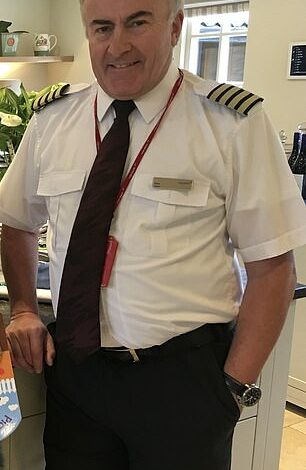What is it like to fall immediately after takeoff and can turbulence cause a crash? Ex-Virgin Atlantic captain answers questions from nervous pilots

Nervous about flying?
Then you’ve probably wondered whether turbulence can damage the structure of an airplane, what that unsettling feeling of falling after takeoff is, and why engines at 37,000 feet can suddenly sound like they’ve stopped working.
Curious about the explanation?
Former Virgin Atlantic captain and social media sensation ‘Pete the Irish Pilot’ revealed them all in a fascinating Q&A on YouTube, along with answers to other questions such as ‘what’s the safest place to sit on a plane?’ and ‘are there any airlines you wouldn’t fly?’
Read on for fascinating insights from an experienced pilot.
Is it true that pilots don’t train for water landings?
Your browser does not support iframes.
Pete, who has more than 40 years of flying experience, says: ‘That’s not true. It’s something you do in your initial training. We do wet exercises with the cabin crew… and in my day you had to demonstrate every three years that you could do an emergency landing procedure with the aircraft, in the simulator of course, after a complete engine failure, where there was no airfield to land at. So it’s definitely trained and checked.’
What is the worst mechanical or electrical failure you have ever encountered?
Pete, who flew fast jets before his commercial career with the RAF, says: ‘I was once flying from Heathrow to Miami and was struck by lightning just above Windsor.
“We found out later that we had been hit 45 times. It took out all the instrumentation – this was on an Airbus A340-600 – on the first officer’s side.
‘So I only had my primary screens on the left side, but thanks to the redundancy of the aircraft we were still able to dump fuel off the coast of Wales and return to Heathrow, dodging the clouds like a Cessna 150.
“It’s really amazing what you can do in an air traffic emergency. We felt like kids in a candy store and had a great time, even though only 50 percent of the cockpit was working.”
Can severe turbulence lead to structural failure of the aircraft?

‘Pete the Irish Pilot’ has over 40 years of flying experience
Pete says, “No. The plane is tested to many times the stress that severe turbulence will put on the plane during flight. The professionalism and the airmanship of the crew keeps you out of all the cumulus clouds, the big weather changes, the storms. So the plane may bounce and thump, but believe me, it’s much stronger than you could ever imagine.”
What is the safest place to sit on a plane?
Pete says, “Any seat is safe. Sitting near an exit? Probably better than sitting far from an exit. As for comfort to minimize the effect of turbulence or aircraft movement, sit near the center of gravity where the wings are. So over-the-wing exits are the answer to your question.”
Have you ever been on a flight where you felt like something was going to go wrong?
To the questioner, Pete says, “No, I’ve never been on a flight where I thought it would go the way you suggest in your question.
‘Sometimes I felt like I had earned my daily wage, but there were also situations where I had to think long, hard and outside the box to find a solution, because the training couldn’t cover everything. But I never thought that it would all go wrong.
‘There is always a solution.’
Have you ever landed within 10 minutes and the cockpit crew said, ‘Cabin crew, we can land in 10 minutes’?
Pete says, “Where I worked [Virgin Atlantic]We didn’t have a 10-minute-to-landing call. I think that’s more of a short-range call than a long-range call.’
Which airlines would you not fly and why?

Aircraft tested ‘well beyond the limits you would experience in a normal flight’
Pete says: ‘I would rather not travel with some of the budget airlines in Asia, South America and Europe.
‘I’m not a Ryanair fan. I don’t mind EasyJet at all. Good operation. Do I like BA? No, I don’t. Do I like Singapore Airlines, Lufthansa, Emirates?
‘Yes, I do.
“Given the number of airlines in the world, that’s an incredibly difficult question to answer.”
I’m terrified of the ‘falling’ you experience during turbulence…

Turbulence ‘doesn’t mean the plane is going to fall out of the sky’
Pete says, “Don’t be afraid. The plane is clearly flying through the air, but the air it’s traveling through is also moving and there are ripples in it. Just like the surface of a road, you can get a pothole, you can get a bubble, and that’s largely what caused what you’ve experienced.
‘It doesn’t mean the plane is going to fall out of the sky, the wings aren’t going to blow off, the engines aren’t going to fail and the pilots aren’t going to lose control of the plane.
‘I highly recommend that you relax and let the plane do its thing. It has been tested far beyond the limits that you would experience on a normal flight.
‘[Planes] ‘It remains the safest form of transport in the world.’
Why doesn’t it negatively affect flight performance if I don’t put my phone in airplane mode?
Pete says: ‘I have not seen any evidence to support the need to turn phones off or put them on airplane mode. However, it is something that is required by all aviation authorities worldwide.
“It’s on the safe side, so you shouldn’t complain. And who cares if you can’t receive email for a few hours.”
In mid-flight, at 37,000 feet, it sounds like the engines have shut down and you feel like you might pass out at any moment…
Pete says, “I can assure you that you are not about to succumb. It could have been a rush in the air conditioning system and that surge has subsided and you have mistaken that as the engines slowing down or stopping. I can assure you that is not the case.
‘Engines must increase and decrease their thrust to maintain speed in turbulence or due to other factors.
“It’s a bit like when you’re driving a car: you press the gas pedal and you take your foot off the gas pedal… but you’re not going to crash.”
What does it feel like when you fall, just after take-off?
Pete says: ‘I think your question is about the reduction in thrust after takeoff. There comes a point during takeoff from the runway, about 1500 feet above the ground, where the pilot brings the thrust levers back to a lower setting and to accelerate has to bring the nose of the plane down, so it goes from quite steep to less steep, but it’s still climbing… you may have misinterpreted that as a sense of “oh, we’re going down”. You’re just going up less steeply.
“You don’t have to worry.”
Should we avoid low-cost airlines?
Pete says, “Absolutely not.”
For more from Pete the Irish Pilot, visit his Instagram profile at www.instagram.com/petethunishpilot/ and his YouTube channel – www.youtube.com/@PetetheIrishPilot.




